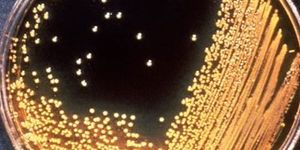Why Blood Cells Originate in Bone
Adults typically have to produce new blood cells every day; around one percent of red blood cells are renewed daily. For a typical person, that means making another 200 billion or so red blood cells, 10 billion white blood cells, and 400 billion platelets every day. Those cells are made in bone marrow, where the ‘blood stem cell niche’ resides. It has been found that the niche is located in different places in various animals, and now researchers have found a potential reason why. The blood stem cells reside in a place where they’re protected from sunlight and its harmful UV rays.
This work could improve blood stem cell transplant safety. It was reported in Nature by scientists at the Harvard Department of Stem Cell and Regenerative Biology, Boston Children's Hospital's Stem Cell Program, and the Harvard Stem Cell Institute. A simple, keen observation led to this study.
"I was trying to look at blood stem cells under the microscope, but a layer of melanocytes above the kidney blocked my view," said Friedrich Kapp, M.D., now at the Center for Pediatrics, University of Freiburg Medical Center in Germany. Melanocytes make melanin, a pigment that gives human skin color; those cells are opaque in zebrafish.
"The shape of the melanocytes above the kidney reminded me of a parasol, so I thought, do they provide UV protection to blood stem cells?" noted Kapp.
Normal zebrafish and zebrafish engineered to lack melanocytes were exposed to UV radiation. Indeed, Kapp found that there were fewer stem cells in the melanocyte mutants. Additionally, blood stem cells were lost from normal zebrafish after they were turned over and irradiated. That showed that the shield provided by the melanocyte umbrella protected the blood stem cells from UV.
The long evolutionary history of the niche illustrates its biological significance. After looking at the evolutionary tree, the researchers found that melanocytes have been hanging out with the blood stem cell niche for so long, their relationship exists in a fish species that diverged from vertebrates about 500 million years ago. In a more recent species, one kind of poison dart frog, blood stem cells migrate from kidney covered melanocytes to bone marrow. All the while, the niche is shielded from light.
"We now have evidence that sunlight is an evolutionary driver of the blood stem cell niche," said Leonard Zon, M.D., senior author of the study. Zon is a Harvard professor of stem cell and regenerative biology, the Grousbeck Professor of Pediatrics at Boston Children's Hospital, and a Howard Hughes Medical Institute Investigator. He is featured discussing his research in the video.
Zon plans to continue this work, to characterize biological signaling cascades that impact the relationship between blood stem cells and melanocytes. That will help researchers learn more about the niche, which will improve blood stem cell transplants.
"As a hematologist and oncologist, I treat patients with blood diseases and cancers," said Zon. "Once we understand the niche better, we can make blood stem cell transplants much safer."
Sources: AAAS/Eurkealert! via Harvard University, Britannica, Nature









